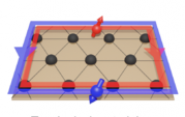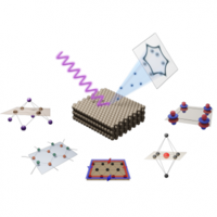ARPES: Reviewing a Technology's Impact on Materials Research

Over the past decade, angle-resolved photoemission spectroscopy (ARPES) has emerged as the key tool for solid state materials research. With a recently published paper in Reviews of Modern Physics, a team of researchers took a close look at its rapid rise over the past two decades.
 In the field of condensed matter physics, the structure of a material’s electrons is key to answering many questions about its properties - electrical resistivity, thermal conductivity, and even why a certain metal looks the way that it does. Since it was discovered that a material’s electronic structure is essentially its fingerprint, researchers in the field have been looking for direct and efficient ways to extract this defining feature.
In the field of condensed matter physics, the structure of a material’s electrons is key to answering many questions about its properties - electrical resistivity, thermal conductivity, and even why a certain metal looks the way that it does. Since it was discovered that a material’s electronic structure is essentially its fingerprint, researchers in the field have been looking for direct and efficient ways to extract this defining feature.
With ARPES, a highly focused x-ray beam pushes out electrons from a material. The direction and energy of these electrons can then be analyzed simultaneously.
“When I just entered the field, one would hold this - as we joked - 2003 ARPES bible and study this complex technique word-by-word.” says He, assistant professor of applied physics at Yale, speaking of the canonical ARPES review published almost 20 years ago. Today, the technology has advanced enough to give researchers a thorough picture of a material’s electronic structure in a matter of hours, and it’s become one of the most prominent tools to investigate functional materials. To encapsulate the explosive development and provide a modern entry point for researchers, the Yale and Stanford scientists figured it was time for an update. He worked on the review in a joint effort with Dr. Jonathan Sobota and Prof. Zhi-Xun Shen from the Stanford Institute for Materials and Energy Sciences at SLAC National Accelerator Laboratory.
“ARPES is a technique that has evolved a lot over the past 20 years - initially it rose to prominence in the field of simple metal, semiconductor and high-temperature superconductor research 30 to 40 years ago,” He said. “Back then, it was based mostly on plasma lamp and synchrotron experiments. In the last 20 years, there have been dramatic improvements in ultraviolet laser technologies, accelerator technologies, and also detector technologies. In the meantime, in a very cooperative way, a lot of new ‘quantum materials’ - or modern functional materials - started to show up. That also helped this technique take off very, very quickly.”
The researchers said their paper is aimed at helping others catch up on on a field of research that is quickly evolving.
"With 1,000-plus articles published per year, it's daunting to stay up-to-date on the latest developments in the field,” Sobota said. “We hope this review will be a useful resource to new students as well as seasoned researchers."
Shen noted that major changes in the field prompted him and and his colleagues to write the paper.
“Advances in synchrotron instrumentation and data analysis drove a paradigm shift in using photoemission to study quantum materials, which had a huge impact on physics,” Shen said. “Now that we’re on the verge of another paradigm shift driven by exciting new modalities involving spin, space, time resolution and in-situ materials synthesis and control, it is high time to summarize the strides that have been made and to prepare for the advancements to come."
This new review covers this technique's decisive role in the rise of quantum materials, including graphene, topological materials, high-temperature superconductors, 2D moirée materials, and even time crystals.
This 72-page, 1,100-reference review of the technology is a thorough one, but the authors write that its impacts on the field are far from over:
“ARPES will continue to be a leading tool pushing the frontier of quantum materials research, helping to set the intellectual agenda by testing new ideas, discovering surprises, and challenging orthodoxies. There is little doubt that this technique is going to be at the focal point of the necessary debates leading to new paradigms of physics.”
Go here to see the full paper: https://journals.aps.org/rmp/abstract/10.1103/RevModPhys.93.025006

